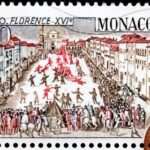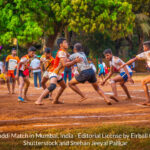
Results
Scores compiled from results reported on Calcio Storico Fiorentino Official Facebook Page. Please vist the Calcio Storico Fiorentino Facebook Page for Official Results as well as videos of the matches. [References: 2-4]
Report
Rossi di Santa Maria Novella triumphed 9-2 versus Azzurri di Santa Croce in the Final of Calcio Storico Fiorentino (Florentine Football in Costune). Rossi had earlier defeated Verdi di San Giovanni 7½-2 and Azzurri had despatched Bianchi di Santo Spirito 7-3 in the Semi-Finals. The victory was Rossi’s first since 2019 in the competition, played since the Renaissance in the Italian Tuscan city of Florence.
TEAMS
| Team | Translation |
| Azzurri di Santa Croce | Blues |
| Bianchi di Santo Spirito | Whites |
| Rossi di Santa Maria Novella | Reds |
| Verdi di San Giovanni | Greens |

Azzurri v Bianchi 2012
Florence – jun 24 fighting players during calcio fiorentino match on june, 24,2012 calcio fiorentino calcio storico or calcio in costume is an historic florentine game, origins of modern football. Copyright: mkistryn [Internet] Available from: https://www.123rf.com/photo_26115132_florence-jun-24-fighting-players-during-calcio-fiorentino-match-on-june-24-2012-calcio-fiorentino-ca.html [Accessed 25 June 2022]
ABOUT
Calcio Storico Fiorentino has been played in Florence, Tuscany since the Renaissance. The first organised match took place on February 17, 1530. It was revived in the 20th Century, first under the 1930s government of Mussolini, and then again after World War II in the Italian Republic. Earlier matches dating back to the 1400s mention games played in breaks between work by workers [Reference: 2-5]
The matches usually take place during the June Festival period, with four teams, Azzurri, Bianchi, Rossi and Verdi (Blues, Whites, Reds and Greens) representing the four quarters of the city of Florence. The match is played between 54 players – two teams of 27 – with teams reversing ends after each score. It is played on sand in the Plaza. There are usually a Semi-Finals and Final. Half Points are scored, and teams play in traditional dress. [References: 4-5]
The game play features the 27 players playing on a rectangular field of sand, measuring 80 metres by 40 metres. Nets at each end of the field span the entire width of the field. The aim is to score more goals than the opponent. Each team consists of 4 Goalkeepers, 3 fullbacks, 5 halfbacks and 15 forwards. There are little or no rules to the game. Players can punch, kick, wrestle or headbut their opponents, but cannot kick to the head and more than one player cannot attack another player at any one time. There are no substitutes and if your team has a player ejected or injured they are down a man. [References: 10]
Players are volunteers and the strategy of the forwards is to incapacitate or injure the opposing team while the halfbacks and fullbacks try to run with the ball through to other endbefore trying to score. Cacce (Goals) are scored by throwing or kicking the ball into the opposing teams net. If the ball goes over the net a half-cacce (half-goal) is scored for the opponent [References: 10]. The Rules were first described by Giovanni de’Bardi (a Florentine count) in 1580 and the draw for the semi-finals is made on Easter Sunday by drawing four different coloured balls. [Reference: 11]

Stamp from Monaco depicting Calcio Fiorentino
[11] MONACO – CIRCA 1963: A stamp printed by MONACO shows an illustration of the Calcio Fiorentino field and starting positions from a 1688 book by Pietro di Lorenzo Bini, Florence, circa 1963 [Reference: 7] By Sergey Goryachev / http://www.shutterstock.com
References
Logo References
[1] Calcio Storico Fiorentino Facebook (2022) Profile Picture [Internet] Available from: https://external-dub4-1.xx.fbcdn.net/emg1/v/t13/14757605033774122771?url=https%3A%2F%2Fwww.ticketone.it%2Fobj%2Fmedia%2FIT-eventim%2Fteaser%2Fevo%2Fartwork%2F2022%2Fcalcio-storico-biglietti.jpg&fb_obo=1&utld=ticketone.it&stp=c0.5000×0.5000f_dst-emg0_p1240x382_q75&ccb=13-1&oh=00_AT_PG8FvC3Cmr-jduZETXLx2SohICbM9489h7BqBFsZdww&oe=62B88E48&_nc_sid=c504da [Accessed 25 June 2022]
Results References
[2] Calcio Storico Fiorentino Facebook (2023) May 25, 2023 [Internet] Available from: https://www.facebook.com/CalcioStoricoFi/posts/pfbid02hmnpfAqYYNvfFvPLwKBSMTAqnkEehw5a1qr4sdgvQepZrb2ctB6kDmz1txJqsyx2l [Accessed 25 June 2023]
[3] Valeri Pagni Facebook (2022) June 11, 2023 [Internet] Available from: https://www.facebook.com/valerio.pagni.37/posts/pfbid02VPjYidTNWZzjD2ZLF7n9YhYXaXhVbuHr77o4e7RtoSsVyifDhXp8qhXdmnxZKnALl [Accessed 25 June 2023]
[4] Azzurri di Santa Croce Facebook (2023) June 23, 2023 [Internet] Available from: https://www.facebook.com/azzurrisantacroce/posts/pfbid02vR2aF7mVTG5DAh1tMpLMnRaotWTso2FkKgiq2JY9HFF36zUTiS7BP2js4HaFrKWnl [Accessed 25 June 2023]
[5] Calcio Storico Fiorentino Facebook (2022) June 23, 2023 [Internet] Available from: https://www.facebook.com/CalcioStoricoFi/posts/pfbid03xJmw3XRWXLKphJ8MufFouA8gx2LJTQGhuVpff2j3s6ZMg72bQYfYLGv6ZtSg7Mgl [Accessed 25 June 2023]
[6] Calcio Storico Fiorentino Facebook (2022) June 24, 2023 [Internet] Available from: https://www.facebook.com/CalcioStoricoFi/posts/pfbid02XFCQqHkhsEskizLxk34qWQKtZ1L7RT5JspASvCdhrkNQEjE5snBroBHrcxdQe1ZRl [Accessed 25 June 2023]
Logo References
[1] Tornabueni (2019) colori-calcio-storico_wp-1024×700 [Internet] Available from: https://www.tornabuoni1.com/it/2019/05/16/i-colori-del-calcio-storico-fiorentino/ [Accessed 25 June 2023][Cropped]
History References
[5] Calcio Storico Fiorentino Sito Ufficiale (2020) Risultati Partite [Internet] Available from: http://www.calciostoricofiorentino.it/risultati_partite [Accessed 4 August 2020]
[6] Calcio Storico Fiorentino Sito Ufficiale (2020) Albo d’Oro [Internet] Available from: http://www.calciostoricofiorentino.it/risultati_partite [Accessed 4 August 2020]
[7] Calcio Storico Fiorentino Sito Ufficiale (2020) CALCIO STORICO FIORENTINO [Internet] Available from: http://calciostoricofiorentino.it/?q=calcio-storico-fiorentino [Accessed 4 August 2020]
[8] Calcio Storico Fiorentino Sito Ufficiale (2020) Studies & Documentation [Internet] Available from: http://www.calciostoricofiorentino.it/?q=studi_e_documentazione [Accessed 4 August 2020]
Rules
[13] You Tube Ninh Ly Channel (2017) The Rules of Calcio Fiorentino – EXPLAINED! [Internet] Available from: https://www.youtube.com/watch?v=obneC8zQNIQ&t=55s [Accessed 25 June 2022]
IMAGES
[9] Calcio Storico Fiorentino Sito Ufficiale (2020) IMG_0823 [Internet] Available from: http://calciostoricofiorentino.it/sites/default/files/IMG_0823.jpg [Accessed 4 August 2020]
[10] FLORENCE, ITALY – FEBRUARY 17, 2020: Calcio Storico and the rallying of the troops By BAHADIR ARAL AVCI / http://www.shutterstock.com
[11] MONACO – CIRCA 1963: A stamp printed by MONACO shows an illustration of the Calcio Fiorentino field and starting positions from a 1688 book by Pietro di Lorenzo Bini, Florence, circa 1963 By Sergey Goryachev / http://www.shutterstock.com
[12] FLORENCE – JUN 24 Fighting players during Calcio Fiorentino match on June, 24,2012 Calcio fiorentino calcio storico or calcio in costume is an historic florentine game, origins of modern football By mkistrynhttp://www.123rf.com
[14] Visit Florence (2022) Event – Calcio Storico Fiorentino [Internet] Available from: https://www.visitflorence.com/florence-events/calcio-storico-fiorentino.html [Accessed 25 June 2022]
ACKNOWLEDGEMENTS
Thanks to Francesco.
ABOUT THIS DOCUMENT
Researched, compiled and written by Enda Mulcahy for the
Eirball – Irish North American and World Sports Archives
Last Updated: 25 June 2023
(c) Copyright Enda Mulcahy and Eirball 2023
You may quote this document in part provided that proper acknowledgement is given to the authors. All Rights Reserved. The Logos and Photos used in this article remain the property of the organisations and individuals which own the copyright and are used here for educational and information purposes only.









